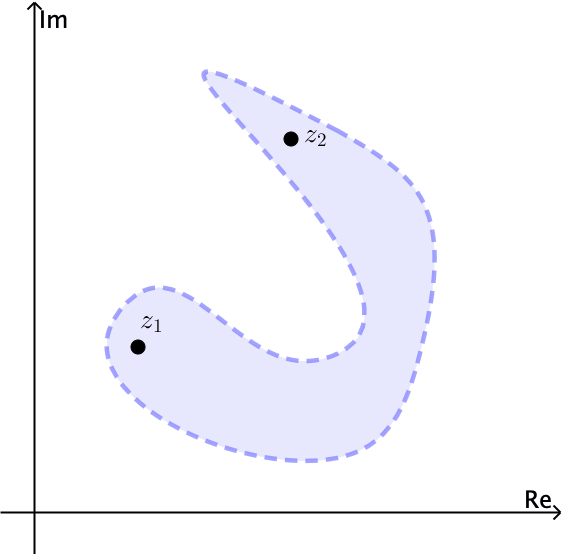Topology of the Complex Plane
Neighborhoods
An $\varepsilon$ neighborhood, also called open ball or open disk, of a complex number $z_0$ consists of all points $z$ lying inside but not on a circle centred at $z_0$ and with radius $\varepsilon>0$ and is expressed by
- $B_{1}(0)=\{z:|z|\lt 1\}$
- $\overline{B}_{\frac{7}{8}}\left(-1-\sqrt{2}i\right)=\left\{z:|z-\left(-1-\sqrt{2}i\right)|\leq \frac{7}{8}\right\}$
- $\overline{B}_{\frac{1}{2}}\left(2+\sqrt{3}i\right)\setminus \left\{2+\sqrt{3}i\right\}=\left\{z:0 \lt |z-\left(2+\sqrt{3}i\right)|\leq\frac{1}{2}\right\}$

Classification of points
A point $z_0$ is said to be an interior point of a set $S\subset \mathbb C$ whenever there is some neighborhood of $z_0$ that contains only points of $S$; it is called an exterior point of $S$ when there exists a neighborhood of it containing no points of $S.$ If $z_0$ is neither of these, it is a boundary point of $S.$ A boundary point is, therefore, a point all of whose neighborhoods contain at least one point in $S$ and at least one point not in $S.$ The totality of all boundary points is called the boundary of $S.$
In this text we will use the following notation:
- $\text{Int } S=\left\{z: z \text{ is an interior point of } S \right\}$
- $\text{Ext } S=\left\{z: z \text{ is an exterior point of } S \right\}$
- $\partial S=\left\{z: z \text{ is a boundary point of } S \right\}$

Considering the previous examples of neighborhoods, let
- $\text{Int } S_1=B_1(0)$
- $\text{Ext } S_1=\{z: |z|>1 \}$
- $\partial S_1=\{z: |z|=1 \}$
For $S_2$ we have:
- $\text{Int } S_2=B_{\frac{7}{8}}\left(-1-\sqrt{2}i\right)$
- $\text{Ext } S_2=\left\{z:|z-\left(-1-\sqrt{2}i\right)|>\frac{7}{8}\right\}$
- $\partial S_2=\left\{z:| z-\left(-1-\sqrt{2}i\right)| =\frac{7}{8}\right\}$
And finally, for $S_3$ we have:
- $\text{Int } S_3=B_{\frac{1}{2}}\left(2+\sqrt{3}i\right)\setminus \{2+\sqrt{3}i\}$
- $\text{Ext } S_3=\left\{z:|z-\left(2+\sqrt{3}i\right)|>\frac{1}{2}\right\}$
- $\partial S_3=\left\{z:|z-\left(2+\sqrt{3}i\right)|=\frac{1}{2}\right\}\cup\{2+\sqrt{3}i\}$
Topological space
A set $S$ is open if for every $z\in S,$ exists $\varepsilon>0$ such that $$B_{\varepsilon}(z)\subset S.$$ That is, $\text{Int } S= S.$ A set $S$ is closed if it contains all of its boundary points, that is $$\partial S\subseteq S.$$ The set $\mathbb C$ is both open and closed since it has no boundary points.
The set $\mathbb C,$ together with the collection $\tau =\{S\subseteq \mathbb C: S \text{ is open} \}$ is a topological space, and this is expressed by the pair $\left(\mathbb C, \tau\right).$ The topological space $\left(\mathbb C, \tau\right)$ satisfies the following:
- $\emptyset$ and $\mathbb C$ are open.
- Whenever two or more sets are open, then so is their union.
- Whenever sets $S_1$ and $S_2$ are open, then so is $S_1\bigcap S_2.$
Remark: The technical definition of topological space is a bit unintuitive, particularly if you haven't studied topology. In essence, it states that the geometric properties of subsets of $\mathbb C$ will be preserved when continuous transformations (functions or mappings) are applied.
The closure of a set $S$ is the closed set consisting of all points in $S$ together with the boundary of $S.$ In other words $$\overline{S}=S\cup \partial S.$$
In general, a set is connected if it cannot be expressed as the union of two disjoint nonempty open sets. An open set $S$ is polygonally connected if each pair of points $z_1$ and $z_2$ in it can be joined by a polygonal line, consisting of a finite number of line segments joined end to end, that lies entirely in $S.$ An open set $S$ is connected if and only if $S$ is polygonally connected.

Notice for example that the open set $|z| \lt 1$ is connected. The annulus $1 \lt |z| \lt 2$ is open and also connected, see Figures 4 and 5.


A nonempty open set that is connected is called a domain. In this context, any neighbourhood is a domain. A domain together with some, none, or all of its boundary points is referred to as a region. In other words, a set whose interior is a domain is called a region. A set $S$ is bounded if there is $R>0$ such that $$S\subset B_R(0)=\{z\in \mathbb C: |z|\lt R\}.$$

Exercise: Sketch the set $S$ of points in the complex plane satisfying the given inequality. Determine whether the set is (a) open, (b) closed, (c) a domain, (d) bounded, or (e) connected.
- $\text{Im}(z)\lt 0$
- $-1\lt \text{Re(z)} \lt 1$
- $|z|>1$
- $2\le |z - 3+4i |\le 5$